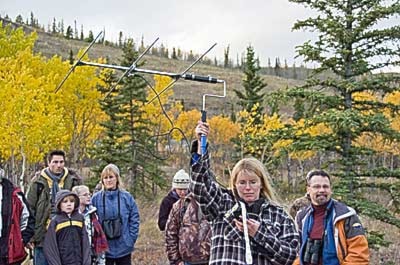With a pair of elk strolling along a half-kilometre down the path, no one was close enough to see the look in their eyes. But it is a safe bet that the male, with his antlers reaching towards the sky like a set of arthritic hands, was disappointed and perhaps a little confused.
Expecting another elk because of the calls sounded by some members of the group, the elk stared quizzically at the group of 30 people out on a wildlife talk/viewing hosted by Environment Yukon.
“Environment Yukon basically is educating the public,” said Stefan Gottermann, one of the department’s wildlife viewing technicians.
“So we organize all these events and, of course, there’s lots of stuff going on during the summer,” added Gottermann, speaking of the roughly 25 events hosted this year.
After meeting at the rest area 500 metres south of the junction of the Klondike and Alaska highways, a caravan of about eight vehicles set off to the Takhini Valley in search of the herd.
Using a telenemeter (radio tracking device) to locate some nearby elk that have been fitted with tracking collars, the binocular and camera-wielding group set off on foot, eventually coming across two, or possibly three, elk off in the distance.
Operating both store-bought and homemade elk bugles that sound like tiny trombones, it was possible to draw the elk into the open.
“It’s not like going to a zoo, it’s wildlife viewing: you never know what you’re going to get,” said Gottermann. “We were lucky that we had the radio collars because that enabled us to at least find ones in the area.
“But the animals, they’re moving around,” added Gottermann. “We had a good idea of where they were … It’s not that the animals stay there and we can say with 100-per-cent certainty that you’ll see them.”
Organizers were thrilled with the high turnout of viewers to the event; however, the number of people may have prevented better viewing.
“It was one of those situations where if we had been less people, chances would have been higher that (more elk) would have come out,” said Gottermann. “People turning on their cameras and, I’m not sure, but at one point I think I heard a cellphone.”
Nonetheless, the unpredictability adds to the excitement, he said.
“That was my impression, that that’s what the people also liked about it. When you go to a wildlife viewing event, it may turn out really cool — you might get really close to the animals — and it may not.”
The Takhini herd, which numbers between 150 and 200, is one of two herds in the Whitehorse area. The other is the Braeburn herd.
“The Braeburn herd we don’t have quite as good a count on yet,” said Rick Ward, a moose, elk and deer biologist with Environment. “But we think we got somewhere between 50 to 100 elk in that group.”
Both herds were reintroduced to the Yukon in the 1950s, with subsequent introductions in the 1990s. But since the elk disappeared from the region so long ago, the term “reintroduce” does not seem appropriate for everyone.
“Some have called it a reintroduction,” said Ward. “Actually the most recent record of elk naturally occurring in the Yukon was about 1,500 years ago. So in my mind, calling it a reintroduction is a bit of a stretch.”
Some herds do exist in the Yukon naturally, having migrated up from Northeastern BC.
“We anticipate over time they’ll move further into the territory,” said Ward.
Some straggler groups splintered off from the Takhini and Braeburn herds may also exist in the Tutshi, Tagish and Minto areas.
“Incidentally, we got a report of an elk yesterday just in Rabbit Foot Canyon,” said Ward. “That’s the first time we’ve had an elk that close to town.”
The elk are currently in the rut. It’s a time of the year in which elk bugling is most common, as elk attract mates for breeding. Elk are harem breeders, which means the males try to acquire groups of females to breed with while fending off other males.
Over the last year, Ward has been overseeing a management program to control the spread of winter ticks among the herds.
About 60 per cent of the Takhini herd was rounded up and held from March through August, the period when the tick’s life cycle comes to an end and it drops to the ground.
“So when we released them in August, we know they were free of ticks,” said Ward. “And our expectation is holding those guys in captivity while the ticks dropped off, we should have reduced the ticks on the landscape by 60 per cent.”
Ward is planning to recapture much of the Takhini Herd this winter to further the eradication of the ticks. Plans to do the same with the Braeburn herd are also in the works.
Despite the effort, Ward is aware that he may be waging an unwinnable war on the ticks.
“From what we hear from the experts, it’s highly unlikely that now that we have ticks, we’ll ever be able to get rid of them,” said Ward. “That continues to be our objective, but it seems like, at this point, we’re looking at a long-term control program to reduce the risks of ticks getting onto other wildlife, such as moose and caribou.”
Environment is distributing a new Wildlife Viewing Guide, which instructs nature lovers how to view wildlife along major highways. The free guide, which can also be downloaded on the internet, features useful tips, viewing etiquette and, of course, descriptions of wildlife and the areas they inhabit.
